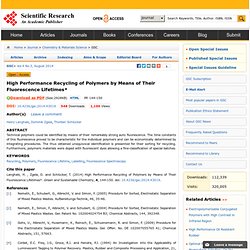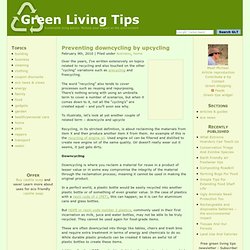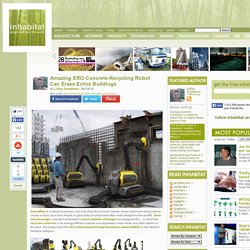

High Performance Recycling of Polymers by Means of Their Fluorescence Lifetimes* High Performance Recycling of Polymers by Means of Their Fluorescence Lifetimes* Technical polymers could be identified by means of their remarkably strong auto fluorescence.

The time constants of this fluorescence proved to be characteristic for the individual polymers and can be economically determined by integrating procedures. The thus obtained unequivocal identification is presented for their sorting for recycling. Furthermore, polymeric materials were doped with fluorescent dyes allowing a fine-classification of special batches. Cite this paper. Living Green: Downcycling and Upcycling. By Michael BlochGreen Living Tips.com Created: March 11, 2010 Last Updated: November 30, -0001 Organisers of the World Conservation Congress in Barcelona on October 6, 2008 elevated recycling to a new, colour-coded level of sophistication, with six different options for throwing away refuse.
(Lluis Gene/AFP/Getty Images) Over the years, I've written extensively on topics related to recycling and also touched on the other "cycling" variations such as precycling and freecycling. The word "recycling" also tends to cover processes such as reusing and repurposing. There's nothing wrong with using an umbrella term to cover a number of scenarios, but when it comes down to it, not all the "cyclings" are created equal, and you'll soon see why. To illustrate, let's look at yet another couple of related terms—downcycling and upcycling. Recycling, in its strictest definition, is about reclaiming the materials from item X and then producing another item X from them.
Downcycling Another example is paper. Preventing downcycling by upcycling. February 9th, 2010 | Filed under business, home Over the years, I’ve written extensively on topics related to recycling and also touched on the other “cycling” variations such as precycling and freecycling.

The word “recycling” also tends to cover processes such as reusing and repurposing. There’s nothing wrong with using an umbrella term to cover a number of scenarios, but when it comes down to it, not all the “cycling’s” are created equal – and you’ll soon see why. To illustrate, let’s look at yet another couple of related term – downcycle and upcycle Recycling, in its strictest definition, is about reclaiming the materials from item X and then produce another item X from them. Downcycling Downcycling is where you reclaim a material for reuse in a product of lesser value or in some way compromise the integrity of the material through the reclamation process; meaning it cannot be used in making the original product. The green cycles: recycling, precycling, freecycling, upcycling, downcycling and e-cycling - Louisville Green Living. The Green Cycles help to keep materials in use (in a cycle) and not in landfills or elsewhere in the environment.

Each cycle fulfills the 3 R's of the environment (Reduce, Reuse and Recycle), Learning these can help you to create less waste, save you money and help you to have a more beautiful and healthy environment. These cycles are great to teach children as well. They make great family and school projects because they can be implemented at home, school, office or wherever you may find yourself. Each of the Green Cycles has a different specific function, but they all help to improve the planet in their own way. The Green Cycles: Recycling is processing used materials into new products, which results in less waste of potentially useful materials, less consumption of fresh raw materials, less energy usage and less water and air pollution.Precycling is thinking ahead before you buy.
Amazing ERO Concrete-Recycling Robot Can Erase Entire Buildings. Demolition is a messy business—not only does the process require heavy machinery and produce clouds of dust, but it also results in giant piles of rubble that often head straight for the landfill.

Omer Haciomeroglu, a student at Sweden’s Umeå Institute of Design has designed Ero – a robot that recycles concrete in an energy-efficient manner and separates it from rebar and other debris on the spot. The project won the 2013 International Design Excellence Award (IDEA) in the Student Designs category. Heavy machines used in demolition consume large amounts of energy in order to crush concrete walls into small pieces, not to mention that demolition processes have to be accompanied by large amounts of water sprayed onto the structures to prevent the spread of dust. Once the work is done, the rubble is transported to recycle stations where waste is separated manually. Power crushers are used to pulverize the concrete and the metal is melted for reuse. + Omer Haciomeroglu Via Core77. Curry cure: Chillies are the hot new thing in medicine - health - 28 February 2014.
Could the heat of some spices solve some of medicine's biggest problems?

(Image: Spencer Wilson) Understanding why mint tastes cool and chilli is hot could bring new cures for chronic pain, obesity and even cancer IT STARTS out as a pleasant tingle, before growing into a burning sensation that feels like your whole mouth is ablaze. You sweat, you cry, and your nose streams. You gasp for water, but it feels like nothing can douse the flames. Anyone who enjoys a curry knows this feeling – and chefs have been using the sensation of chillies and other peppers to spice up their culinary experiments for centuries.